Archive for the ‘#simmsfishing’ Tag
Feel Your Way…….
Hidy Ho Good Neighbors,
So, have you tried Euro style nymphing yet? I know, sounds funny coming from a guy that wrote a book about the systematic approach to nymphing, but I have done a fair amount of this technique over the last couple of years. Even have my clients working a modified euro system on pretty much every guide trip.
Now, I’m no expert on euro style, but I appear to be qualified enough to talk about it because my clients catch plenty of fish, even on the first time out, using my quirky method. I tagged my method “eurorado nymphing” because it includes Colorado nymphing methods coupled with euro-style principles. I’ve included a section in my latest book, Hidden in Plain View, that goes into greater depth on what I do.

A good stocking stuffer
Suspended nymphing under an indicator still has a place in my arsenal as it can create longer more consistent drifts, gives you the ability to work water that is more than a couple rod lengths away, and gives you the ability to see fish eats thru the indicator. However, the ability to work the upper half of a drift effectively while dialing in drift speeds is a bit tougher under an indicator. Think back to the last time you nymph fished, how many fish did you catch upstream of the halfway point of your drift? Exactly, it’s hard to recall because it just doesn’t happen as often as the fish you catch from the middle to end of the nymph drift. That’s because that is when most anglers have the depth and speed finally perfect.
Eurorado style, on the other hand, allows you to work the upper part of the drift well. It allows you to feel working over obstructions, shelves and bars. And, you catch the majority of the fish above the middle point of your drift, because you get the bugs down quickly, and dial in depth and speed quickly after your bugs hit the water. Each method has its merits, but like I always say, the more versatile an angler you are, the more you’ll enjoy the sport.
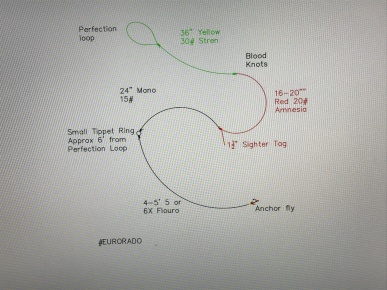
Customize as needed
Some days Eurorado nymphing is like a vacuum, picking up fish in a river where suspended nymphing wouldn’t be able to and it’s relatively easy to rig and learn. Again, I’m no expert, but there are many videos available that can get you started. As for gear, I run a 10’6” 3 weight Master Nymph Bellator fly rod with a matching Lamson Liquid reel. This rig is balanced and light weight with incredible accuracy and fish fighting capabilities. I also employ a sighter-leader of my design and use bugs of my design.
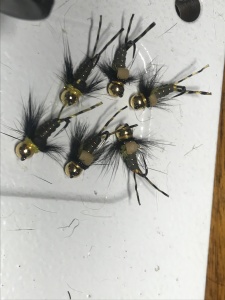
A gaggle of Booby Traps
The sighter-leader and flies used is where I put the “rado” in this rig, because it smacks of Colorado nymphing. Most Euro-style leaders are around twenty feet (and longer) lengths, whereas my leader is around eleven feet long. It is comprised of several different sections of monofilament, fluorocarbon, and amnesia lines, with a sighter tag and tippet ring thrown in for a cause (see pic). As for my bugs, I run a weighted Booby Trap, as my anchor, and run in-line off of that. So, off the bend of the Booby Trap, I run tippet to a DP643 which is an unweighted soft hackle, and off of that bend I run a Butt Crack Baetis (unweighted) in the appropriate size and color. I’m sure you can see the indicator nymphing influence here.
This rig has served me and my clients well over the last couple of years on the Eagle River, and it can easily be customized to your favorite water with a little thought and tinkering. I continue to learn a bit more each time my boots get wet, but I am sold on this technique. I really enjoy the simplicity, ability to feel your way along a river bottom, and the consistency to get depths and speeds dialed in quickly on every drift.
That’s my story and I’m sticking to it…….Fear No Water!
Happy Holidays!
Hidy Ho Good Neighbors,
It was my eleventh summer and a group of my neighborhood buddies and I pooled our resources and engineering prowess to construct a very fine tree fort. This fort had everything, windows that opened and closed, quick exit trap doors, radio antennae, and a rope ladder. We were kings of the tree tops.
Our inaugural sleep-in night was upon us and just after we settled in for the evening someone tossed a lit smoke-bomb into our abode. I remember clicking on my flashlight and being surrounded by stinky blue smoke. We bailed out as quickly as possible, but the night was ruined. All that preparation and anticipation went right down the tubes. We were ticked.
I thought about the smoke-bomb incident the other day as I was standing in a well-known front range tailwater. I spend a lot of time guiding other fly fishers and every so often; I get to hit the river by myself, which is always a treat. I plan, re-rig my fly rods, spin a few special flies, and no matter how tired I am from the weeks work, I’m always up early and anxious to go.
I arrived much earlier than the other anglers, and had settled into a favorite run. This run has room for one angler, is choked with willows on the anglers backcast, and the perimeters can be easily reached with a decent roll cast. In other words, it’s a small section of river that a modest fly caster can cover top to bottom and bank to bank, without moving an inch.

Crowded rivers can lead to poor etiquette, unfortunately.
I had settled in, and put a couple small rainbows and one decent brown trout in the bottom of my net in around fifteen minutes. I smiled to myself after landing the last fish, relaxed a bit, and lit my pipe. Just then, I hear splashing below me in the run as two anglers step into the drink. They both look at me as I angle my head to the side, hitting them with a “What are you going to do?” non-verbal cue. One of the guys stops in his tracks, the other proceeds to place a roll cast into my run while trying to avoid eye-contact. His first cast, had I been in a drift, would have crossed my line!
I turned facing him and uttered, “Really, this is the best you can do?” He didn’t say a word, backed out and took his partner with him. I stood there for a minute shaking my head. I stripped out some line and readied for my next upstream presentation, when all of a sudden, those two knuckleheads bust through the willows on the bank above me, waded in, and began to fish. I could have easily cast over both of their lines. Smoke-bomb in the tree house!
I rigged up my rod and slogged over to the bank. Just before leaving I reminded them that they needed to learn some manners, and mentioned something about trout in public places, and we not only need to respect the fish, but the fishermen as well. They heard me but neither had the courage to make eye contact. I’m still pissed.
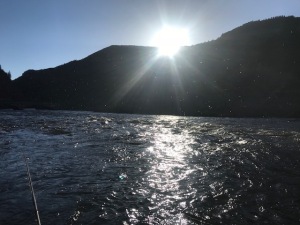
Can’t always be like this, but we can play nicely…..
The majority of anglers know fishing etiquette. Always ask folks which way they plan to fish, upstream or downstream, give them plenty of room, and extend to them the same courtesy you would expect from others. Don’t walk the banks above an angler working a run. That’s a good way to spook fish he is working. Always try to give them the run they’re in and the shelf above it. I’ll often ask if it’s ok to hit the run above them, if it’s a good distance above the shelf that marks the top of their run.
Maybe that’s part of it, folks don’t know how to read the river, which gives them no discernable start and stop places. Maybe they simply need to learn a typical run; riffle, shelf, pool, glide, tailout, riffle. Frankly, I’m not confident that will solve the issue, this comes down to a “me first” mentality. An ”I need this fish picture for my social media”, mentality. Yep, I’m still a little pissed.
I am more than annoyed at what fly fishing has become on our crowded rivers in Colorado. So many anglers, packed into a few miles of rivers. Still, I think with a healthy dose of etiquette, we could have fun days even on highly pressured waters. I have been preaching fishing etiquette for as long as I can remember, and there are days when it’s certainly more than annoying, but we have to keep teaching protocol one angler at a time. Fear No Water!
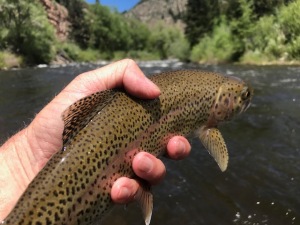
Simply remember the golden rule
Of Redds and Run-off
Every year I hear the same old crap about folks ripping spawning fish off Redds. Drives me crazy, infuriates me really. How can you interrupt something as sacred as spawning fish? That’s our guarantee for future fishing, and there ain’t nothing wrong with wild fish, or the fish helping out in the quest for more fish. Our respective game and fish departments can’t do it all.
Maybe some folks just don’t know what to look for, so here goes: look for water up to about thirty inches deep with areas that looked like they’ve been swept with a broom. Usually, this is a flatter section of the river, with slower moving water. Also, look for one or more fish sitting atop this swept out area. I’ve seen redds the size of a coffee table, up to the size of an auditorium. Both are equally easy to spot if you’re paying attention.
You may be thinking, “So where do I fish then?” The answer is simple, “Not on the redd, but above or below it.” Target the species not spawning on the shelves and pools below spawning fish. Hmmmmm, wonder what patterns to throw…You can certainly toss egg patterns in your nymph rigs and follow that up with the fly of the day, or the dominant hatching insect. No mystery, really, just do your best to be observant, step around the redds, and fish anywhere but on them.
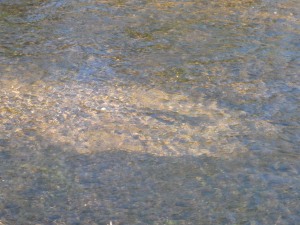
Pretty dang obvious Redd. Just observe.
Run-off is bearing down on us as the water rises and goes off color. My day usually starts out nymphing two and three bug rigs under an indicator, using darker and sparser bugs. I like weighted flies (odd for me, but conditions call for it), with dark and sparse materials, to get the bugs down quickly and allow the fish to readily see them. The darker colors are easier for fish to see in off-color water. I tie my favorite flies in black, purple, red, and even throw in some true fluorescent orange and pink collars to provide for “hot-spots” and visibility.
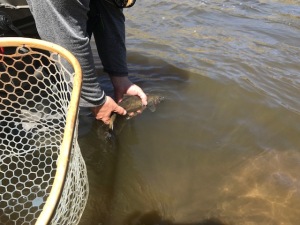
Little dirt in the drink.
Lately, my days have been ending throwing the mini-rig (it’s in the book), with a black Chubby Chernobyl followed by a black soft hackle (DP643), and a size 18 purple Butt Crack Baetis. Killer. The fish are moving to the edges and up into the riffles (not redds) to consume baetis swimmers and emergers, and the occasional skwala stones and migdes. You’ve all heard me preach about carrying two rigged rods, well this time of year is perfect for it. So, mornings I work bottom up, afternoons, top down.
Don’t hesitate to rip streamers as the water’s rising, that can be as productive as it is fun. I like to run tandem rigs with a white or lightly colored streamer up front, followed by a Slumpbuster or similar 20# below on 2 or 3 X tippet. I like to tie a loop knot to the trailing streamer to allow for a bit more movement. Typically, I’ll run a five to six foot tapered leader down to 2 or 3X to my first streamer, tie off the bend with the same to my terminal meat. If you’re not moving fish, you’re probably above their level, so employ more weight, casting angles, or mending techniques to get those streamers deeper. Vary your retrieves, strip set, and hang on.
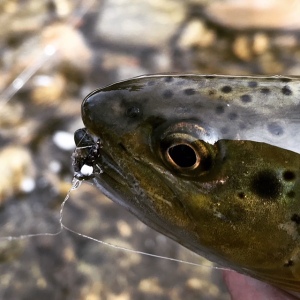
Black soft-hackles during run-off
As we get into full-blown chaos with run-off, focus on the banks, edges, eddy’s, and sleeper seams out from the banks. Just be damn careful stepping into crazy water. Dress appropriately, use a wading staff, take a friend, and show discretion and common sense. It’s not worth dying for.
A few nymphs to consider for run-off:
Black Pat’s Rubberlegs
Black Leeches
Cranefly Larva
Black Soft-Hackles (#16-18)
Purple Butt Crack Baetis (#18)
Purple, Pink or Red San Juan Worm
Various Egg patterns
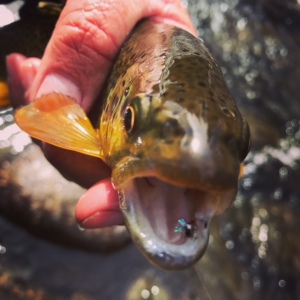
Purple Butt Crack Baetis
Fear No Water…except during run-off










